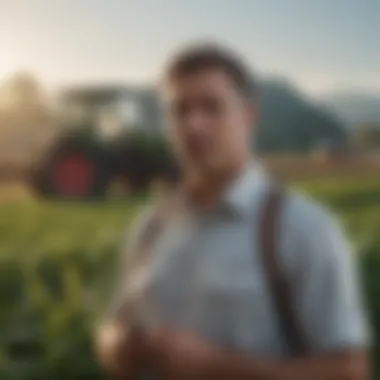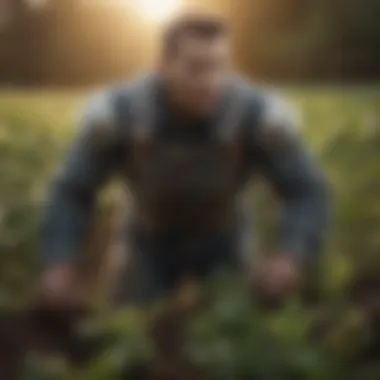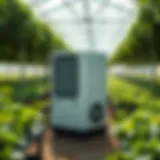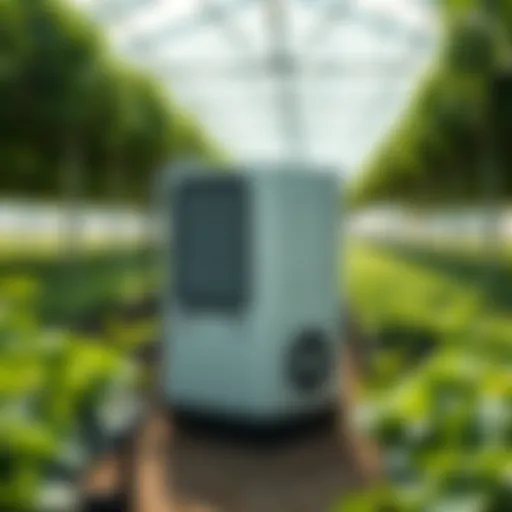Understanding Vydate Price: Key Insights for Farmers


Intro
In the complex landscape of modern agriculture, understanding the pricing dynamics of chemicals like Vydate is crucial for both farmers and agronomists. As Vydate remains an effective pesticide, its pricing not only affects immediate financial decisions but also reflects broader economic trends and sustainable practices. This exploration will provide a nuanced view of the factors influencing its cost, insights into market trends, and alternative methods to improve crop management.
Latest Trends in Agriculture
Overview of Current Trends
The agricultural sector is constantly evolving, influenced by factors like climate change, market demands, and advancements in technology. The movement towards precision agriculture has gained significant traction. This approach minimizes waste and maximizes yield by utilizing data analytics, which in turn affects how pesticides like Vydate are priced and utilized. As farmers adopt these trends, the role of Vydate in their pest management strategies requires reevaluation within the context of their overall operational costs.
Impact of Technology on Farming Practices
Recent technological developments have transformed farming practices. For instance, the integration of drones and satellite imagery allows farmers to monitor crop health effectively. By identifying pest hotspots, farmers can apply Vydate more selectively, reducing overall usage and costs. Moreover, tools such as weather forecasting systems enhance decision-making, allowing farmers to time their applications precisely when pests are most active.
Sustainable Practices: Towards a Greener Future
Importance of Sustainability in Agriculture
Sustainability is becoming increasingly important in agriculture. Farmers are reconsidering their practices to align with eco-friendly methods. Vydate, while effective, is under scrutiny for its long-term environmental impact. Evaluating its use in the context of sustainable practices is crucial for modern agriculture, and it's essential to weigh its benefits against potential ecological risks.
Methods for Sustainable Farming
Several strategies can complement the use of Vydate in sustainable farming. These include:
- Crop rotation: Alternating crops can naturally disrupt pest cycles.
- Integrated Pest Management (IPM): This approach integrates chemical, biological, and cultural practices to control pests with minimal environmental impact.
- Organic alternatives: Farmers can explore organic pest control products that offer lower risks to the environment.
By adopting these methods, farmers can maintain productivity while minimizing reliance on chemical inputs like Vydate.
Gardening Techniques and Tips
Essential Gardening Tools and Equipment
For farmers and gardening enthusiasts, having the right tools is essential. Basic tools include:
- Hand trowel: Useful for digging small holes and transplanting.
- Pruning shears: For maintaining plant health by removing dead or diseased branches.
- Sprayers: Essential for applying Vydate or other pesticides evenly.
Seasonal Gardening Practices
Understanding the seasons is crucial for effective gardening. Some practices to consider are:
- Spring planting: Timing when to plant crops to maximize growth.
- Fall preparation: Ensuring that the land is ready for dormancy can protect against pests and diseases in the following year.
Understanding these gardening techniques can not only support the effective use of Vydate but also inform broader agricultural practices that align with sustainability goals.
Through this exploration of Vydate's pricing and its broader implications in agriculture, farmers can make informed decisions that reflect both their economic needs and environmental responsibilities.
Preamble to Vydate
Vydate plays an essential role in modern agriculture, particularly in pest management. Farmers and agronomists rely on it to protect crops from various pests, thereby ensuring higher yields and better quality produce. Understanding Vydate is crucial, as its application can significantly influence not only the farm's productivity but also its economic viability.
Definition and Purpose
Vydate is a systemic pesticide, meaning it is absorbed by plants and works from within. Its primary active ingredient is oxamyl, a member of the carbamate class of pesticides. This compound is well-regarded for its effectiveness against nematodes, aphids, and other harmful insects. The purpose of Vydate is clear: to provide farmers with a reliable option for managing pest populations that could otherwise devastate crops. By controlling these pests, Vydate aims to enhance overall agricultural productivity and sustainability, aligning with modern agricultural goals to maximize output while minimizing environmental impacts.


Chemical Composition
The chemical composition of Vydate is crucial for understanding its functionality and safety. The active ingredient, oxamyl, is formulated with various inert ingredients, contributing to its effectiveness and stability as a pesticide. When applied, it disrupts the normal functioning of pests, leading to their demise while posing minimal risk to the crop itself.
Moreover, the formulation is designed to allow for easy absorption by plants, providing effective pest control throughout the growing season. Farmers should be aware of the specific composition and its interactions with different crops to optimize its use for improved outcomes.
"Understanding the chemical makeup of Vydate is vital for effective pest management and crop health."
Knowledge about Vydate helps agricultural professionals make informed decisions about its application. Informed use can lead to more sustainable practices in crop management, benefitting both the environment and farm economics.
Market Overview of Vydate
Understanding the market landscape for Vydate is crucial for stakeholders in agriculture. Vydate has carved its niche as a dependable pesticide, noted for its unique efficacy against various pests. This market overview provides insights into the factors that drive demand and supply dynamics, which in turn influence Vydate pricing. Addressing elements such as current demand trends and global supply chain factors assists farmers and agronomists in making informed decisions regarding their crop management strategies.
Current Demand Trends
The demand for Vydate is primarily dictated by agricultural practices that prioritize effective pest management. Farmers are constantly looking for solutions that not only protect their crops but also ensure optimal yield. The rising awareness about integrated pest management has led to an increased interest in Vydate. Its proven effectiveness against rootworms and other invasive pests enhances its desirability.
Several trends contribute to this demand:
- Growing Crop Production: As food security becomes a global imperative, farmers are turning to Vydate to enhance crop resilience.
- Regulatory Approval: Vydate's compliance with stringent regulations secures its acceptance in various regions, encouraging its use.
- Evolving Consumer Preferences: Shifts towards sustainable and organic farming practices sometimes drive demand for Vydate, as it can fit within integrated pest management approaches.
This consistent demand suggests that the market for Vydate is likely to remain robust in the near future.
Global Supply Chain Factors
The pricing and availability of Vydate are also closely related to supply chain dynamics on a global scale. Several factors may impact the supply chain that includes production, logistics, and distribution.
- Raw Material Availability: The production of Vydate relies heavily on specific chemical inputs. Fluctuations in the availability of these materials can lead to variations in pricing.
- Manufacturing Capacity: If manufacturers face limitations in production or scaling issues, this can restrict supply and increase prices.
- Transport and Distribution: Efficient logistics networks are necessary for reaching farmers. Disruptions in transport, whether from geopolitical issues or natural disasters, can hinder supply.
- International Trade Policies: Tariffs and trade agreements affect the flow of Vydate between countries. Understanding these regulations is important for stakeholders who depend on it.
"A stable supply chain is essential for maintaining the market balance and ensuring fair pricing for Vydate."
A comprehensive grasp of these supply chain factors allows farmers to anticipate price changes and adjust their purchasing strategies accordingly. By staying informed about both the demand and supply dynamics, stakeholders can better navigate the complexities of the Vydate market.
Factors Influencing Vydate Price
Understanding the various factors that influence the price of Vydate is crucial for farmers and agricultural stakeholders. The fluctuations in price can have significant implications for farming budgets and crop management strategies. To grasp the economic landscape surrounding Vydate, one must consider three key elements: production costs, regulatory impact, and market competition. These aspects collectively shape how Vydate is priced in the market, influencing purchases and usage decisions by farmers.
Production Costs
The production costs of Vydate serve as a foundational element in its pricing structure. These costs include raw materials, manufacturing processes, and logistical expenses. As prices for inputs like chemical substrates increase, the overall cost of producing Vydate becomes more expensive. Additionally, factors such as labor costs and energy prices can impact manufacturing.
Farmers must keep these production costs in mind. If the production costs rise sharply, this impacts the final retail price of Vydate. This, in turn, can lead to increased expenses for farmers, affecting their profitability. It is essential that agricultural stakeholders remain vigilant, monitoring the market for changes in production cost dynamics.
Regulatory Impact
Regulatory frameworks significantly influence Vydate pricing. Government policies and regulations dedicated to pesticide use can impose strict guidelines that affect its approval and application. For instance, if new regulations require additional safety testing or environmental assessments, this can delay or increase the cost of bringing Vydate to market.
Compliance with these regulations also introduces additional costs for manufacturers. Often, these costs are transferred to consumers, directly impacting the price. Farmers must be aware of such regulatory changes, as they not only influence the price of Vydate but can also dictate its availability and permissible usage frequencies in various regions.
"The cost of compliance will often reflect in market prices, shaping farmer choices and environmental strategies."
Market Competition


Market competition plays a critical role in determining Vydate's price. A vibrant competitive landscape can lead to pricing pressures among manufacturers. If multiple companies produce similar products, this encourages them to keep prices competitive to attract buyers. Conversely, if the number of suppliers is limited, they can exert control on pricing, leading to higher costs for farmers.
Farmers should pay attention to the dynamics of the pesticide market. An understanding of competitors, their pricing strategies, and product offerings allows for better-informed purchasing decisions. Keeping abreast of new entrants to the market or innovative alternatives can also provide beneficial insights into achieving cost-effective solutions for crop management.
Analyzing Historical Price Trends
Analyzing historical price trends of Vydate is crucial for understanding its market behavior. Knowledge of price movements over time provides valuable insights for farmers and agriculture stakeholders. By examining these trends, one can identify patterns that may signal future price changes. Additionally, understanding historical fluctuations helps in planning crop management practices and budget allocation more effectively.
Price Fluctuations Over the Years
The price of Vydate has experienced significant fluctuations throughout the years due to various market forces. In the early stages of its introduction, pricing was relatively stable as production mechanisms were established and demand levels remained consistent. However, as the agricultural landscape evolved, factors such as shifts in demand, changes in production costs, and regulatory impacts have introduced more variability.
- Demand Surge: In certain years, an increase in pest pressures has led to a surge in demand for Vydate. This spike in demand often correlates strongly with increased crop production efforts, leading to temporary price hikes.
- Production Cost Variability: The costs associated with producing Vydate, such as raw materials and labor, have also changed over the years. When input costs rise, manufacturers may pass these increases onto consumers, causing spikes in prices.
- Regulatory Changes: New regulations or environmental guidelines can also disrupt pricing stability. Stricter pesticide regulations can limit availability, thus driving prices higher.
Ultimately, to effectively manage their operations, farmers must remain informed about these trends. Knowing when to purchase herbicides can save significant costs and impact crop yields.
Economic Events Impacting Prices
Multiple economic events have had profound implications on the pricing of Vydate. Understanding these events helps stakeholders predict potential future price changes based on economic indicators.
- Global Economic Fluctuations: Changes in the global economy, such as recessions, can result in reduced spending in agriculture. When farmers face economic hardships, demand for Vydate may decline. This decreased demand can lead to lower prices, which can benefit farmers seeking to control operational expenses.
- Trade Policies: International trade agreements and tariffs directly affect the price of agricultural inputs. Tariffs imposed on pesticides or their raw materials can result in increased costs for Vydate, affecting final consumer prices.
- Market Competition: The competitive landscape also defines price trajectories. If new entrants join the market offering similar products or alternatives, prices may reduce as companies vie for market share.
"Understanding historical price themes and economic influences equips farmers with critical information. This helps to navigate potential changes in expenditure for essential supplies."
Gaining insights into the economic fabric surrounding Vydate enables better strategic planning for crop management and resource allocation.
Regional Pricing Variations
Understanding regional pricing variations is crucial when analyzing the cost of Vydate. Prices can differ significantly from one region to another, influenced by various factors such as local demand, availability, and regulatory conditions. For farmers, these variations can affect profit margins and overall farming strategies. By comprehending how and why these regional differences exist, farmers and agronomists can make better informed decisions regarding the use of Vydate in their crop management practices.
North American Market
In North America, the pricing of Vydate is subject to market demand and local agricultural practices. The agricultural sector here is highly advanced, with a focus on maximizing yield while maintaining sustainability. Contingent on factors like crop type and geographical location, the cost of Vydate can vary. For example, in states where specific pests are prevalent, demand for Vydate may surge, thereby driving up the price. However, generally, the competition among suppliers tends to keep prices relatively stable. Moreover, North American farmers often have access to government programs that may subsidize some costs, creating a complex interplay of pricing.
European Market Dynamics
In Europe, Vydate pricing is influenced by strict regulations regarding pesticide usage. Countries are adapting to sustainable practices, which sometimes limits the distribution. The varying acceptance of Vydate across different countries introduces further complexity. For instance, while Germany has a high demand for this product, some other European countries may favor alternative pest control methods. As a result, the pricing in regions with stricter regulations may be higher due to the costs associated with compliance and limited supply. Farmers must also consider the environmental impact of their choices, which might lead them to a willingness to pay a premium for Vydate to ensure effectiveness while adhering to regulations.
Developing Markets
Developing markets present a unique scenario regarding Vydate pricing. In these regions, farmers face a dual challenge: accessing quality agricultural inputs like Vydate and managing costs. Prices can be lower compared to developed markets, but availability is often limited. Infrastructure inadequacies and logistical hurdles can exacerbate pricing issues, impacting how much Vydate farmers can actually use. Furthermore, as these markets slowly embrace modern agricultural practices, pricing can fluctuate dramatically, depending on both local and global trends. Farmers in these regions must be astute in navigating these challenges to maximize their crop yields while managing costs.
"Understanding local market conditions is key to optimizing the use of Vydate and managing costs effectively."
In summary, regional pricing variations of Vydate are a reflection of multiple factors, including market demand, regulatory environments, and the specific agricultural contexts of each region. Farmers must engage with these dynamics to make effective and economically viable decisions.
Vydate Price and Crop Management Practices
Understanding the price of Vydate is crucial for effective crop management. As an essential pesticide used widely in agriculture, Vydate's cost affects farmers' decisions daily. Price influences the quantity that farmers can afford, impacting crop health and yields. Thus, analyzing Vydate's price in relation to crop management practices is not just about figures; it is about sustainability and productivity.
Cost-Benefit Analysis
A cost-benefit analysis is an integral part of assessing Vydate in agricultural practices. This process allows farmers to evaluate the return on investment when applying this pesticide. The key elements to consider in this analysis include:


- Input Costs: This includes the purchase price of Vydate, application equipment, and labor needed for application.
- Expected Returns: Yield increases must be estimated. Farmers should look at past data on increases in crop yield with Vydate usage versus without it.
- Long-Term Benefits: It's essential to consider not only immediate financial return but also the health of the soil and future harvests.
Farmers can utilize this analysis to determine whether the benefits derived from Vydate justify its price. In many cases, spending on effective pesticides results in far higher yields and profits. However, each farmer must evaluate their specific conditions, such as crop type and location.
Integration with Sustainable Practices
Integrating Vydate into sustainable farming practices is a challenging yet important aspect of modern agriculture. While Vydate is effective, its use must align with sustainable guidelines to minimize environmental impact. Consider the following points:
- Target Application: Farmers should apply Vydate only when the threat of pests reaches a specified threshold. This helps prevent unnecessary use of chemicals, which can lead to resistance.
- Combination with Biological Controls: Using Vydate alongside natural pest control methods can enhance sustainability. This dual approach can reduce reliance on chemicals over time.
- Monitoring and Adjusting Practices: Farmers should monitor crop health and adjust their application rates based on specific needs. This reduces waste and keeps costs down.
By thoughtfully integrating Vydate into crop management, farmers can maintain productivity while promoting environmentally friendly practices. It is a balancing act that requires careful evaluation but can lead to sustainable farming outcomes.
"In the pursuit of profitability, we must not overlook the principles of sustainability. Each decision impacts both our yield and our environment."
Alternatives to Vydate
In the realm of agricultural pest management, the exploration of alternatives to Vydate is crucial. Farmers increasingly seek effective solutions that not only meet their agricultural needs but also align with sustainable practices. Alternatives can provide farmers with various advantages, such as reducing dependency on a single product, managing resistance in pest populations, and promoting ecological health in agricultural systems.
The decision to consider different products is influenced by several factors. Farmers need to evaluate the effectiveness of the alternatives, their environmental impact, and, importantly, their cost. This review of alternatives allows for personalized crop management strategies suited to specific agricultural conditions. It also enhances resilience against pests, minimizing the risks associated with pest resistance.
Comparative Cost Analysis
When assessing alternatives to Vydate, a detailed comparative cost analysis is essential. It's important to look at both initial costs and long-term expenses. For example, when examining products like Abamectin or Chlorantraniliprole, the initial purchase price may be lower, yet ongoing applications and their effectiveness over time can sway overall costs.
- Initial Purchase Price: Some alternatives may offer lower prices at first, appealing to budget-conscious farmers. However, their effectiveness must be critically evaluated.
- Application Frequency: Certain products might require more frequent applications, which can increase labor and other operational costs.
- Potential Yield Improvements: The alternative's effectiveness on crop yield is a significant consideration. While the upfront cost may be enticing, a cheap product that does not effectively control pests can lead to greater economic losses in the long run.
By carefully analyzing these aspects, farmers can make informed decisions that balance short-term investment with long-term productivity and sustainability.
Efficacy and Application
Efficacy is a central consideration when reviewing alternatives to Vydate. It is not simply about the cost; products must perform efficiently under varying environmental conditions and pest pressures.
- Pest Spectrum: Some alternatives target broad pest spectrums while others are more specialized. Understanding the particular pest threats on a farm can guide the choice of product.
- Application Method: The method of application can also affect efficacy. Some alternatives may require high precision in application or specific conditions for maximum effectiveness. For instance, Foliar applications might work better in certain conditions, while soil-applied products might be more effective against root pests.
"Choosing the right alternative is not just about price; efficacy must also shine through to ensure that pest issues are managed properly."
- Compatibility with Integrated Pest Management (IPM): It is crucial that alternatives support broader IPM strategies. The selected product should integrate seamlessly with biological controls or environmental practices already in place, contributing to a more holistic pest management strategy.
In summary, understanding alternatives to Vydate encompasses a broad spectrum of considerations from cost to efficacy and application methods. Each choice influences farmers in distinct ways, shaping their field management practices for the current and future agricultural landscape.
Finale
In the intricate landscape of agricultural economics, understanding the price dynamics of Vydate is crucial for farmers and stakeholders alike. The factors influencing the price of this pesticide are not just numbers on a chart; they directly affect decision-making processes in crop management. The conclusion consolidates the key insights and forward-looking statements that shape the future of Vydate pricing.
Summary of Key Insights
Several important insights emerge from the exploration of Vydate pricing dynamics:
- Market Demand and Supply: The relationship between market demand and supply is a major determinant of Vydate's price. A thorough understanding of seasonal trends can help farmers anticipate cost fluctuations.
- Regulatory Environment: Changes in regulations significantly influence production costs and pricing. Familiarity with these regulations enables farm managers to strategize better and possibly reduce expenses.
- Input Costs: The variability in essential inputs for production, such as raw materials, labor, and technology, can have a direct impact on the overall pricing of Vydate.
Emerging trends like sustainable farming practices also highlight the importance of balancing effective pest management with environmental responsibility. Moreover, the rise of alternative pest control solutions affects Vydate’s market positioning, which is an essential consideration for long-term strategic planning.
Future Outlook for Vydate Pricing
Looking ahead, the pricing landscape of Vydate is expected to undergo changes influenced by several factors:
- Technological Advancements: Innovations in agricultural technology promise to enhance the efficacy of pest management strategies. As these technologies are integrated, they may alter how Vydate is utilized and priced.
- Sustainability Practices: The demand for environmentally friendly farming solutions is rising. This shift could pressure traditional pesticide pricing, including Vydate, leading to new pricing strategies that reflect sustainable practices.
- Economic Trends: Global economic conditions will remain a significant factor. Economic stability or instability in key agricultural markets may influence pricing structures due to shifts in consumer spending and investment in agriculture.
In summary, while Vydate remains a key player in pest management for agriculture, understanding its pricing will require constant vigilance regarding market trends and changes. Farmers are encouraged to stay informed about these factors to make better crop management decisions.







